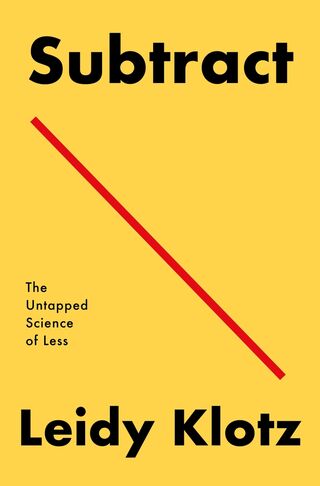Bias
When You Feel Overwhelmed, Subtraction Can Lead to Gains
Leidy Klotz explains why less is sometimes more.
Posted June 9, 2021 Reviewed by Gary Drevitch
Key points
- New research reveals a clear bias in people to solve problems by adding something, rather than subtracting, which can be counterproductive.
- When people are reminded that adding and subtracting are both potential solutions to problems, they are more likely to explore both approaches.
- A shift toward considering subtraction-based solutions could benefit the environment, and lead to simpler, better product designs.
More, more, more! We seem to have an innate drive toward addition—blind faith that more is always better. We make our burgers bigger, add more toppings, and throw in a supersized order of loaded fries. We add so many bells and whistles to word processing software that workshops are needed to learn how to type a sentence. Academia is not immune to the addiction of more, as its solution to a problem is often to hire a few more deans.
We’ve all heard the adage, “Less is more,” but rarely do we put it into practice. We talk too much, drink too much, eat too much, work too much. One can imagine how such a relentless drive would have benefitted our early ancestors, but is it maladaptive in the modern world?
In his new book, Subtract: The Untapped Science of Less, engineering and architecture professor Leidy Klotz shows that our natural tendency to add more often prevents us from spotting easier or more efficient solutions. He’s also published a new supportive study in Nature entitled, “People systematically overlook subtractive changes.” I had the pleasure of asking Klotz about his startling research findings and how they may help us lead better lives.
What led you to start thinking about less? Was there a eureka moment?
My favorite breakthrough outside my scholarly research was when my toddler son and I were struggling to build a bridge using his Duplo blocks. The support towers for the bridge were different heights, and so we couldn’t span them. I reached behind me to grab a block to add to the shorter tower. Then, as I turned back, Ezra was already removing a block from the taller tower.
To be clear, my son has proven that he’s just as unlikely to subtract as grown-ups. But what he lacks in subtractive insight, he makes up for in repetition, and the Duplo bridge was the rare case in which he had stumbled upon taking away as a solution to a problem.

Is the bias towards addition easily remedied by reminders to consider subtraction as an option, or are subtractive options mentally tougher to conceptualize?
They are tougher to conceptualize, in that it takes more mental steps. If adding comes to mind first, it takes a bit more cognitive effort to then consider subtraction. That said, it’s just harder, not impossible. Reminders do help.
People can recognize the value of subtraction once they notice the opportunity. In some of our research studies, participants had been randomly assigned to receive cues that subtraction was an option. Consider our miniature golf set-up, for example. In this study, we had participants imagine they were an assistant manager of a putt-putt course and tasked them with changing one of the existing holes. No-cue instructions did not mention either addition or subtraction, whereas the cue instructions reminded participants of both: “Keep in mind that you could potentially add things to the hole as well as take them away.”
This simple directive increased rates of subtraction. And while the cue also mentioned adding, the rates associated with this type of alteration remained unchanged. Since the cue increased rates of subtraction but not addition, we can surmise that the additive part of the cue was redundant with ideas people were already considering, whereas the subtractive part of the cue brought new possibilities to mind.
One could argue that the idea of subtraction is a relative of the “KISS” (Keep It Simple, Stupid) mantra. In some contexts, I think KISS makes sense, but there’s a risk that it can do a disservice to complex problems. Does KISS relate to subtraction?
Yes, but there is an essential difference between KISS, minimalism, and some of these other mantras. You can keep it simple by not adding. In fact, “keep” it simple suggests not adding in the first place. This is a perfectly fine approach for some problems, but it doesn’t remind us to subtract, which, as we just discussed, is what can really be helpful.
I’m agnostic on the right approach to solving problems. Sometimes adding is good, sometimes keeping it simple is best, and sometimes subtracting is what the doctor ordered. The problem is not that we should always subtract; it is that we should sometimes, and yet we don’t, in part because we systematically overlook this basic option.
Like our drive towards addition can become pathological (I’m thinking hoarders), do you think it is possible that people can overdo subtraction? Is it unhealthy to be too much of a subtractor or minimalist? How can we best balance addition and subtraction?
In the book, I try to help shift this either/or mindset. We need to go from thinking subtract or add, to subtract and add. The add-or-subtract framing makes us try to resolve contradiction. If one idea contradicts another, then one of the ideas must be wrong. If I like subtracting, then I must not like adding. Resolving contradiction is not a bad thing. Doing so has aided reasoning at least since Aristotle, who held that if one idea contradicted another, then one of the ideas had to be rejected. We have this logical reasoning to thank for all sorts of scientific breakthroughs, everything from our single, repeatable, biological classification system to the mathematical logic that led to modern computers.
The problem comes when we try to resolve contradictions between ideas that aren’t actually in conflict. The question is not, “Should we add or subtract?” The question is, “How do we use both?” My research shows that people often add and then move on, failing to consider even superior subtractions. That jump right to adding wouldn’t necessarily be a problem if people then considered subtracting. If more makes things better, then maybe less can, too.

Is the predisposition to add more a cultural universal? In other words, is there a greater proclivity to add more among individualistic versus collective societies?
We need to study this more, but our preliminary evidence, from participant pools in Japan and Germany, shows the same basic predisposition that we found in our U.S. samples. There was some slight variability in the degree of this predisposition across the samples, but it was less than the variability within the samples.
This is a good time to point out that there are two steps to making change. The first is to consider options. Our Nature paper focused on this “considering” stage. People systematically don’t consider subtraction. Of course, after we consider our options, we then get to choose one. My book covers the many reasons people might prefer adding even after they have considered subtraction—everything from social norms for bigger-is-better to economic rewards for growth. And there are certainly theories about how these might vary across cultures.
Do you have a favorite example of improving life using subtraction?
Strider bikes. These are the pedal-less mini-bikes that have given today’s preschoolers high-speed independence that my generation didn’t have until we took off our training wheels. These bikes are propelled not by chains and pedals but by toddlers “striding” with their legs, moving the bike forward like a Flintstones car.
Strider bikes add a couple of extra years at the beginning of kids’ riding careers. What’s more, once my son decided it was time for his “big-kid” bike, we didn’t have to bother with training wheels. He could already balance and just needed to learn to pedal—and then, to brake.
Children’s bikes have been marketed as their own distinct class of bicycle for almost a century. There were plenty of design changes over that time: training wheels, fatter tires, shock-absorbing forks and seats, more and more speeds, and contraptions that connect a kid’s bike to a grown-up’s like a caboose. It’s remarkable, but perhaps not surprising given what we have learned, how long it took for someone to think of subtracting the pedals, which made two-wheeled bikes ridable for a whole new age group—and salable to their parents.
You talk about subtraction as a way to help resolve the tension between infinite growth and a finite planet. Do you really think humanity has a chance at doing this?
Sure, because I think what most people really want is infinite progress, not infinite growth. That said, it is a massive practical and mental challenge to decouple progress from growth. SUBTRACT is my humble contribution to this effort, hopefully spreading the notion that sometimes progress comes from adding, and sometimes it comes from taking away. I think we can do this, or else I’d just play golf in my free time instead of writing books. But maybe I’m too optimistic from all the time I get to spend around students.
LinkedIn image: dokurose/Shutterstock




